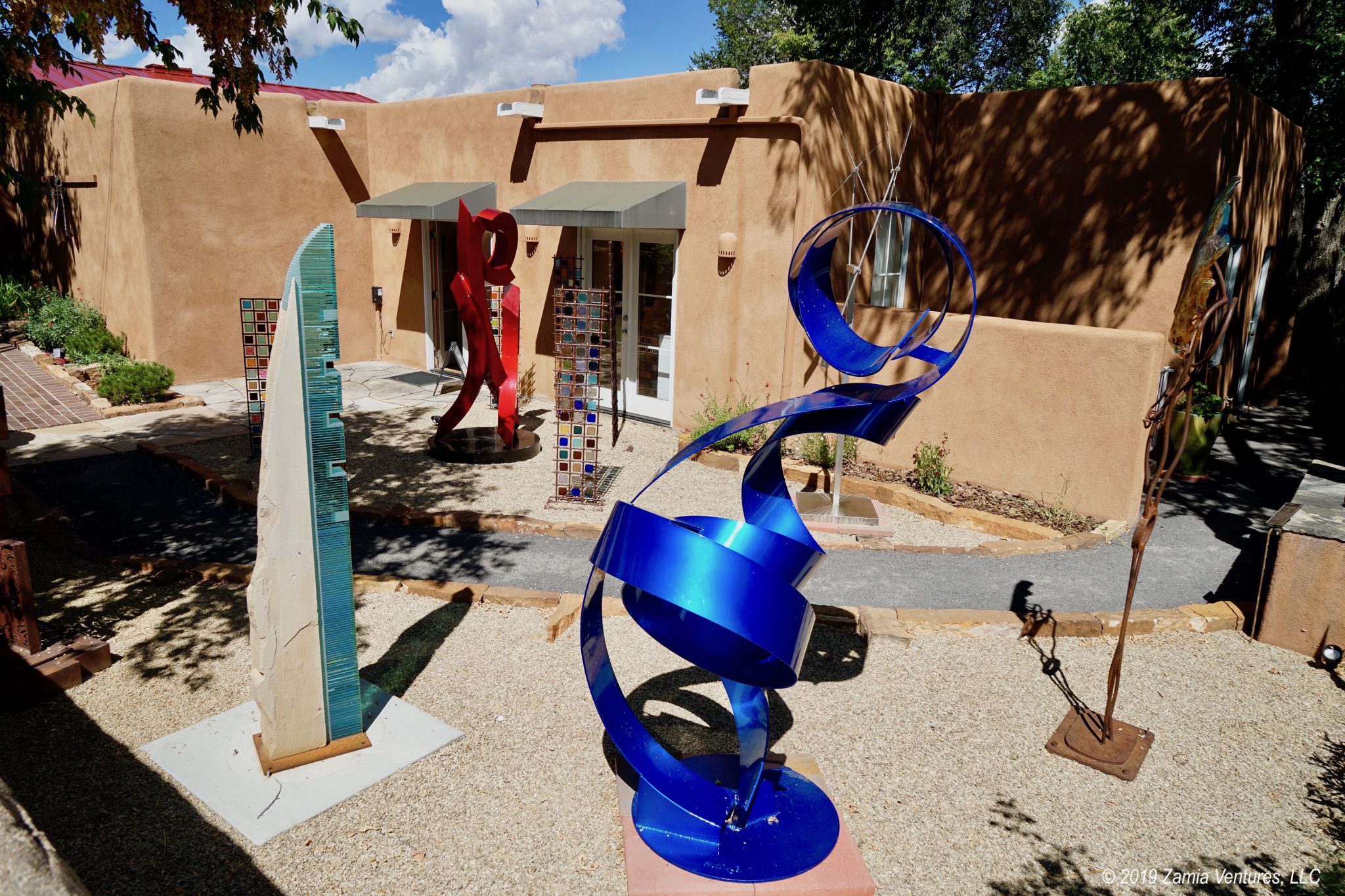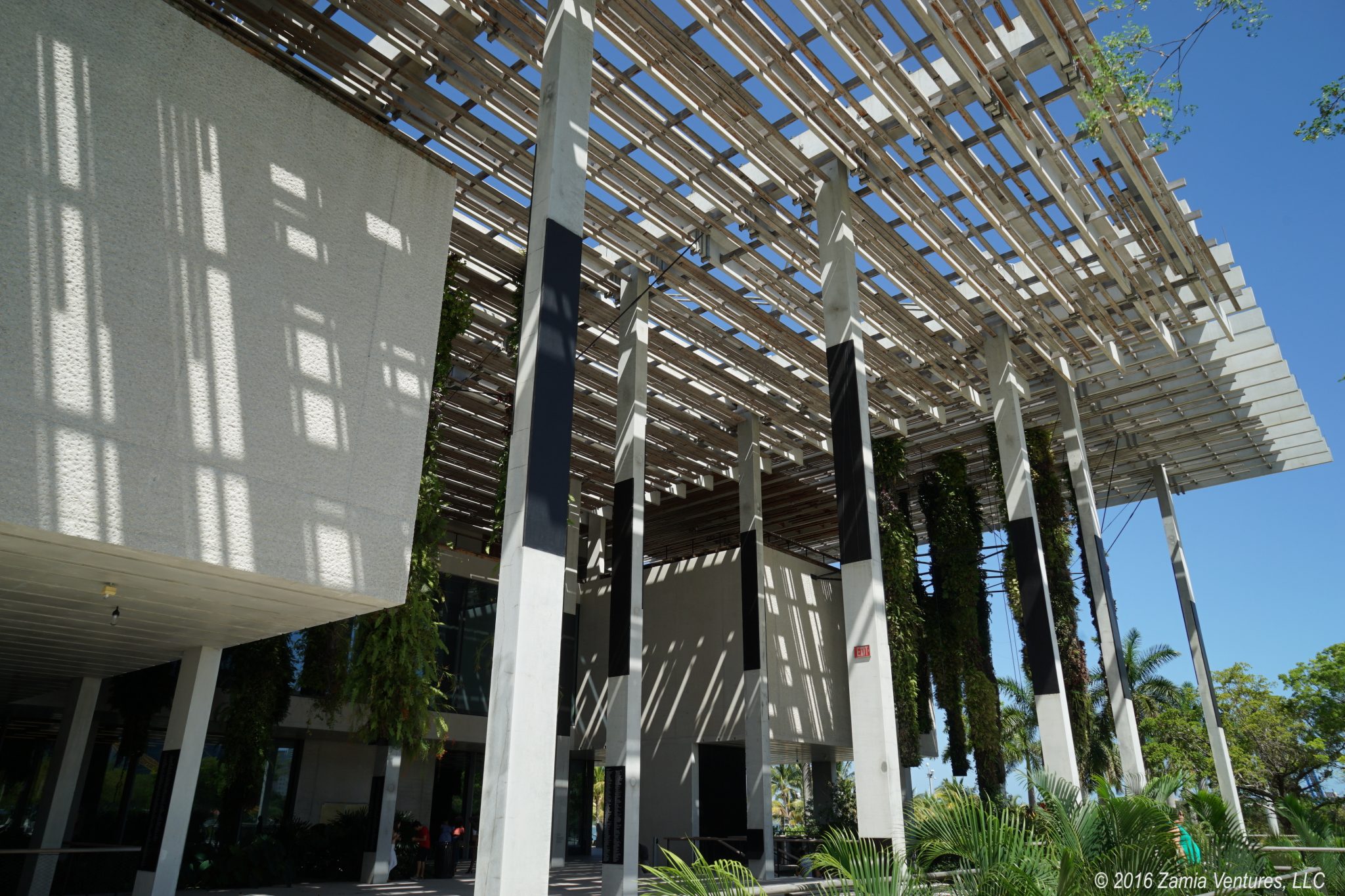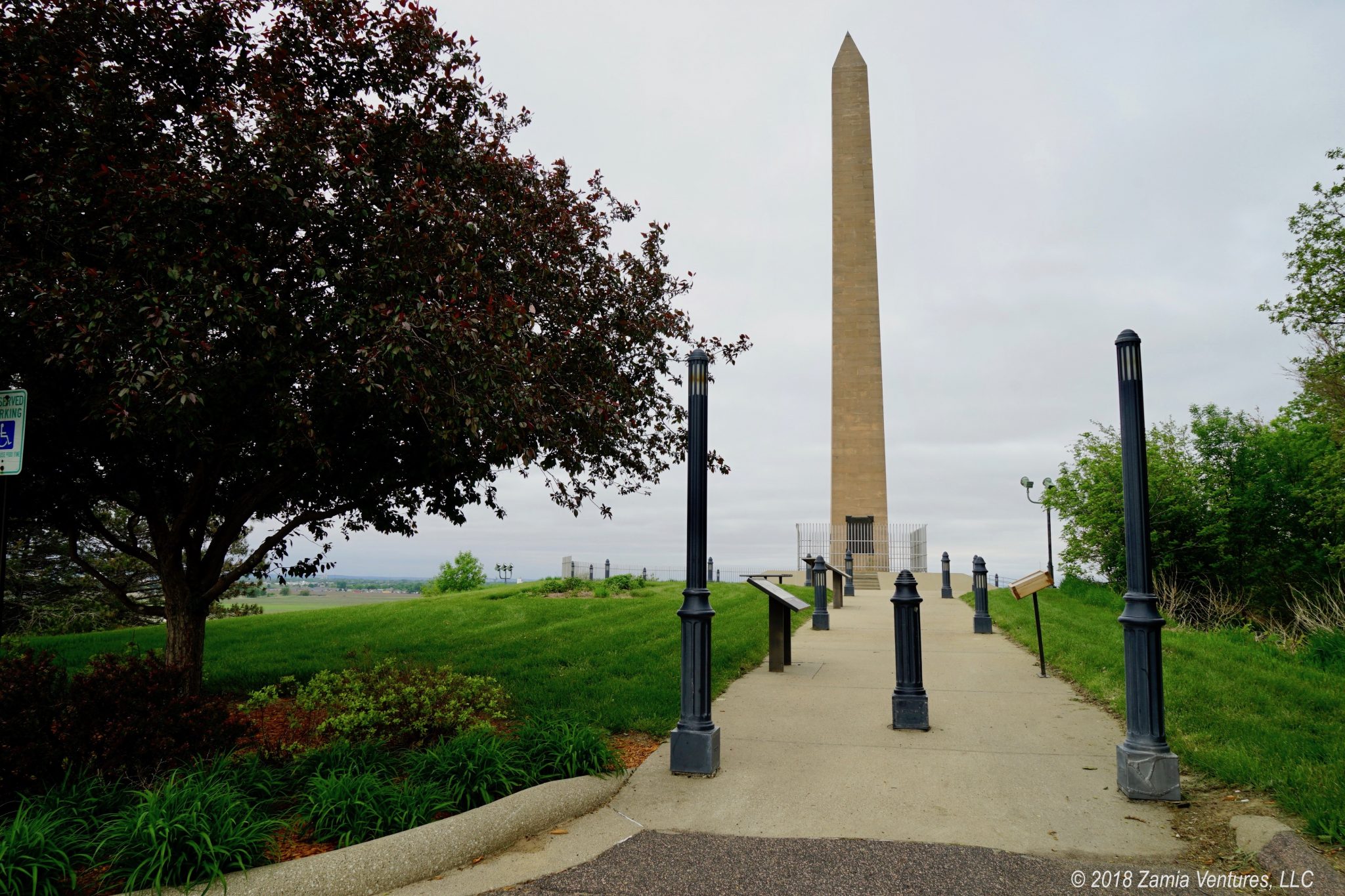A big part of our motivation for selling the Airstream and truck was to switch to a different style of travel: trips by air and trips to large cities, which we tried to avoid at all costs when towing our house behind us. Our first post-Airstream foray was a brief-but-busy trip to Chicago. I hadn’t been in years — and a business trip in chilly December to review documents hardly counts as a visit anyway — while Ken had never been to the city. With a certificate for a free Hilton night expiring soon, we picked an early summer weekend, packed our bags, and headed off for an urban adventure.
We have learned in the course of our years of travels that we enjoy a focused, deep-dive visit to a place much more than a visit that involves “seeing it all” in a few exhausting days. So while Chicago offers an enormous number of activities and destinations, we focused our four days pretty tightly on art and architecture, two topics we particularly love and which are areas of renown for the city.

Art Institute of Chicago
Our top destination in Chicago was the Art Institute, which boasts a towering collection of nearly 300,000 items housed in breathtaking galleries spanning almost a million square feet. The Art Institute is particularly noted for having the best collection of Impressionist and Post-Impressionist works outside of France, along with very important collections in American and Modern Art. It’s simply not possible to take in so much art (or cover so much ground) in one visit — though the museum does offer a highly condensed “what to see if you only have an hour” list on the back of the visitor guide. Putting on blinkers and trotting blindly through room after room of gorgeous works just to snap phone pics of a dozen famous paintings is the complete opposite of our preferred approach to enjoying art. Our solution: we purchased a membership, which paid for itself on our second visit, and spent some time at the Art Institute every single day of our trip.
It’s hard to overstate just how many iconic Impressionist and Post-Impressionist works are in the collection of the Art Institute. If you’ve ever had a poster, notebook, or other tchotchke with an Impressionist or Postimpressionist image, chances are good the original is at the Art Institute. Renoir’s Two Sisters on the Terrace? Check. George Seurat’s monumental pointillist masterpiece A Sunday on La Grande Jatte? Check. Van Gogh’s self-portrait and the image of his bedroom in Arles? Check. The Child’s Bath by Mary Cassatt? Check. Claude Monet water lilies, haystacks, and images of London bridges? Yep, right there among the 46 separate pieces by Monet (26 on exhibit).
We spent several worthwhile hours in these galleries over several days. A core principle of the Impressionist movement was that capturing the feeling and mood of a scene is more important than the accuracy of the depiction. Seeing several different editions of similar works, showing the same scene in different seasons or different times of day, really allowed us to examine how the artists used color and brush technique to present the same basic views in very different ways.

Beyond the Impressionists and the Postimpressionists, the Art Institute also has a very strong collection of American Art. Edward Hopper’s Nighthawks and Grant Wood’s American Gothic headline a collection that runs the gamut from the colonial era to modern times. I particularly enjoyed seeing a varied collection of Winslow Homer works from different periods of his career. The modern and contemporary collection is housed in a spectacular, light-filled wing, and is filled with familiar names like Magritte, Man Ray, Picasso, Modigliani, Pollock, de Kooning, Johns, and Koons.
We really liked that most exhibits showed a variety of arts, not just paintings, all united by a common theme. For example, a gallery of ancient artifacts showcasing the Roman home included the typical decorated pottery serving dishes, but also eating utensils, spice jars, decorative busts, and fragments of floor mosaics. The American galleries in particular combined period artwork with sculptures, furniture, and silver to communicate the complete aesthetic of each period.
We had ample time to enjoy the well-known masterpieces, but we also browsed our way through many interesting collections ranging from architectural fragments of prominent Chicago structures to medieval/Renaissance arms and armor to Asian sculptures. One of the strangely compelling collections is the Thorne Miniature Rooms. Philanthropist Narcissa Niblack Thorne commissioned several dozen well-researched, perfectly-scaled model rooms to illustrate the architecture and interior design of various periods in (mostly) American and European history. The doll house sizing makes them popular with kids, but the level of detail — right down to the miniature woven textiles, wallpapers, and portraits — is remarkable and memorable.
Purchasing the membership to the Art Institute worked out perfectly. Here are my top 4 reasons, in increasing order of importance, why I was thrilled we decided to go that route.
#4: Access to a members-only rooftop lounge with nice views, free coffee and tea (plus other food and drink available for purchase), and ample seating.
Having a quiet place to grab a coffee, relax, and — most importantly — sit down for a while was an excellent addition to our experience at the Art Institute. This familiar yet oversized seating arrangement is actually an art installation on the patio outside the member lounge:
#3: Visiting daily means less art overload
Over a decade ago Ken worked in Manhattan, we had an apartment in NYC, and our best investment was a membership at the Met. We went every weekend I was in town and the biggest luxury was feeling free to leave after 2 or 3 hours when our brains were full. Over the course of a year we managed to see the entire Met, even the Cloisters, while not causing our brains to explode from art and history overload.
While we didn’t have the luxury of spreading out our visits over an entire year in Chicago, visiting daily but limiting each visit to a few collections helped save our tired feet while keeping us more mentally fresh to take in all that we were seeing. We never got to the point where we thought, “Ugh, more art.”
#2: Member access to Georgia O’Keeffe “My New Yorks”
While we didn’t plan this when selecting our travel dates, it turned out that we were visiting during the member preview days for a highly-anticipated exhibit of Georgia O’Keeffe works titled “My New Yorks.” Although O’Keeffe is best known for her southwest-influenced works featuring organic subjects like flowers, from 1918 to 1949 she lived half the year in New York City together with husband Alfred Stieglitz (until his death in 1946). Their annual 1920s winter stays in the Shelton Hotel, the city’s first residential skyscraper, inspired her to explore the geometry of tall buildings and the unique city views afforded from high windows. While we were aware of her New York connections from our prior visit to the Georgia O’Keeffe Museum in Santa Fe, this exhibit really highlighted the importance of the city in the development of her artistic sensibilities.
In addition to seeing the new exhibit without crushing crowds, we attended a members-only lecture by one of the curators which added a lot to our understanding of how the exhibit was assembled and how New York was integral to O’Keeffe’s work. Fun fact: You know all those iconic works with bleached cattle skulls? She completed most of those in New York after shipping the bones back to her studio from New Mexico. The exhibit even includes photos of O’Keeffe with some of those skulls mounted on the patio of her NY apartment.
#1: Daily early access
Every day that the Art Institute is open (Thurs-Mon), the first hour is open to members only. That precious hour gave us the chance to start each day with nearly-private access to the galleries. The opportunity to examine the popular Impressionist works at our leisure was an incredible privilege, while having the museum relatively free of visitors also allowed us to get to our destination collections quickly and make the most of our time there. The early access alone made the membership worthwhile for us.
Boat Tour with Chicago Architecture Center
Chicago has a rich architectural heritage. It was the home of the world’s first skyscraper, the Home Insurance Building built in 1885, made possible by the development of steel-framed buildings and the invention of the safety elevator. In the following 150 years or so Chicago has consistently been at the forefront of building design, and today the skyline is filled with structures representing an incredible variety of styles: Spanish, Gothic Revival, Neoclassical, Art Deco, Modern (International Style), Postmodern, and more. Our excellent introduction to Chicago architecture was a 90 minute narrated boat tour along the Chicago River offered by the Chicago Architecture Center.
Our docent did an marvelous job of explaining topics in a straightforward and engaging manner, while simultaneously providing plenty of granular detail for the nerds in the crowd (that would be us). He covered topics ranging from the different styles of architecture and the physical challenges presented by several of the building locations to broader topics like adaptive reuse of industrial buildings, sustainability, and the process for reversing the flow of the Chicago River. It was much easier to absorb all the information when it was beautifully illustrated by examples right in front of us, and gliding down the very busy Chicago River on a sunny afternoon was a relaxing way to finish off the day.
How Did This Happen?
Long-time readers know that I like to dig into the weeds and understand how things work, so naturally I was curious as to how Chicago emerged as the major metropolitan center of the Midwest, complete with unparalleled architecture and cultural amenities. Why not Duluth, or Milwaukee, or St. Louis? It turns out there are several reasons.
Chicago became one of America’s most vibrant cities in the second half of the 19th century, primarily because of its role as a transportation hub. The Chicago Portage — a 6-mile stretch of wetlands separating the Mississippi River watershed from the Great Lakes and the St. Laurence River watershed — was known to native people for centuries before becoming a point of strategic focus for European powers battling for control over North America. Construction of a canal between the Chicago River and the Des Plaines River in 1848 allowed for inland water transport all the way from New York (via the Erie Canal) to New Orleans. Meanwhile, construction of extensive railroad networks allowed for large-scale shipping of grains and livestock from the Great Plains to markets in the east, and all these transportation lines radiated out from Chicago.
Chicago was a boomtown, with the population exploding from just 30,000 people in 1850 to 300,000 people in 1870. The city was a significant commercial hub, with processing facilities and ports complemented by agricultural banks and things like the Chicago Board of Trade and Chicago Mercantile Exchange. All this success was put in jeopardy when the city was basically destroyed in the Great Fire of 1871; 17,000 structures were lost and 100,000 people were left homeless. City leaders vowed to rebuild, and unsurprisingly implemented stricter fire codes that required more use of stone and brick. Architects flocked to Chicago, drawn by the huge demand for new buildings, and the virtually blank slate created opportunities for experimentation and innovative projects.
Within 20 years the city had more than recovered: the population had topped 1 million people, the continued growth of commerce and agricultural industries in the Midwest made many Chicagoans immensely wealthy, and Chicago was ready to show off. City leaders lobbied hard to be selected as the site for the 1893 World’s Columbian Exposition, a world’s fair celebrating the 400th anniversary of the arrival of Columbus in the Americas. Leading local architect Charles Burnham led the effort to build the fairgrounds, and he recruited the best designers in America to assist. Richard Morris Hunt, Louis Sullivan, Frederick Law Olmsted, and others had key roles in the design of the massive expo complex that ultimately welcomed over 27 million visitors. Wealthy Chicagoans were eager to use the fair to show the world that they were more than sausage-makers and grain dealers. The expo included a fine arts exhibition, and wealthy families went on a purchasing binge between 1890 and 1893 to ensure that they could demonstrate their taste and appreciation of the latest contemporary art. Bertha Honore Palmer, wife of businessman Potter Palmer and President of the Board of Lady Managers of the fair, alone acquired 11 Renoirs and 29 Monets, including 9 of the paintings in Monet’s Haystack series. The fair was a tremendous success, and much of that “contemporary art” ended up in the Art Institute’s Impressionist collection.
So that, friends, is the story of how Mrs. O’Leary’s cow brought architectural dominance and 46 Monets to Chicago.
But wait, there’s more!
This post is already long enough, so in part two I’ll talk about our visits to other Chicago museums, parks, architectural destinations, and dining establishments. Stay tuned!






























I love that you guys are traveling as expected and making the most of your new home-on-wheels free lifestyle. We’ve been doing some 4 day trips to European cities and it’s been great. Enough to get a good feel, without breaking the bank or exhausting ourselves. I also think your decision to purchase a membership to the museum makes a lot of sense. Not only do you get the perks of membership – like that sweet, blessed hour when you didn’t have to deal with all the other visitors – but you’re supporting a good cause. Win win.
I absolutely adore Chicago. The architecture alone blows every American city out of the water. There are no boring buildings and the skyline is just stunning. Interesting background on the whys of that situation. Speaking of stunning, maybe you went up into the Hancock Center or one of the other skyscrapers with viewing areas?? Inquiring minds want to know, but I guess we’ll have to wait til next time. Also, I eagerly await your thoughts on Chicago style pizza – “delicious comforting treat” or horrifying “casserole” as Jon Stewart opined??? 🙂
I think 4 days is just about perfect for an initial city visit. We were very active in our Chicago trip, on our feet all day long, and by day 4 we were definitely feeling it. A longer stay would only work if we built in more downtime. I’m sure it’s the same with your European city visits, with so much walking and sightseeing to be done. We’re very happy with the Art Institute membership. As you note, it supports a good cause that we really like; we’ve considered renewing our Met membership after leaving NYC just because we appreciated the Met so much.
The city skyline in Chicago really is top notch, and there are so many excellent places that provide outstanding views: parks, riverwalk, lakefront promenade, etc. We didn’t feel the need to hit an observation tower during our visit, but I still think you’ll enjoy the amount of skyline photos in my next post. And there’s at least one photo involving melted mozzarella. Teasers!
Hooray for travel! Hooray for traveling somewhere you love with activities you love, too! And hooray for blogging!! I’ve/we’ve never spent any appreciable time in Chicago (drive-thrus and fly-ins to both airports) and aren’t ever likely to, so you guys doing all the work for us is exactly perfect. My favorites include the members-only rooftop lounge and the boat tour — unsurprisingly, both outside activities. There’s just something about the juxtaposition of green spaces in concrete jungles that make them all the more charming. Now add some pizza or a Chicago dog, and we’re all set!
Even though you are not likely to visit, I think you would like Chicago! It’s a very green city (at least in the summer) with massive parks, and also has excellent pedestrian trails along Lake Michigan and the Chicago River. And there is a ton of free entertainment in the city, especially summer concerts and plays in the parks. I was tempted to attend some of the events in the parks while we were there, but we were too tired at the end of our busy days. Next time, perhaps.
We love Chicago! It was one of our favorite cities that we visited in our RV travels. But because we were staying at Indiana Dunes SP, we only had a day the two times we visited, and it wasn’t nearly enough. We did the Architectural Boat Tour, a walking tour of the city, and the Field Museum, among other things, but didn’t go to the Art Institute because we felt like we didn’t have time to do it justice. Which is true, but after reading your post, I’m really bummed that we didn’t go!
I loved your excellent tour. What a fabulous collection, and with everything so interestingly displayed. Your approach of spending a couple of hours at a time enjoying different collections over several days instead of just plowing through the whole thing in a half-day is exactly what I would like to do. What a great way to kick off your new mode of travel! (And now I want to return to Chicago. :-))
We were pretty satisfied with our 4-day visit, though there is so much more to do in Chicago, but it was be really hard to squeeze everything into just one day! But the architecture boat tour is a definite highlight and worth putting at the top of the list, as well as just walking around the city. I think you were smart to postpone the Art Institute for a future visit. As you probably guessed from the post, I have no patience for those people who take the “one hour to see the famous pieces” route. What does A Sunday Afternoon on the Island of La Grande Jatte even mean if you have no concept of what came before or after? Plus they have so many great collections that are not world famous but still extremely interesting and worth exploring. We’re going to enjoy our memberships from afar for the next year, because even the member newsletters are pretty interesting.